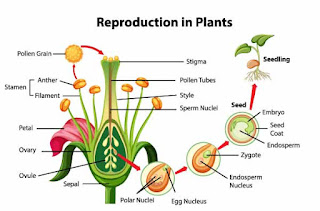Reproduction in Plants Class 7 - Worksheet/Questions
This worksheet is for Class 7 Science and covers the topic of Plant Reproduction. This is an important Science topic that will also serve as a foundation for plant biology in future classes. As a result, students must have a thorough understanding of the subject.
1. Fill in the blanks:
- _________ propagation is the process of producing new individuals from the vegetative component of a parent.
- The transport of pollen grains from the anther to the stigma of the same or another flower of the same species is known as ___________.
- Seed dispersal takes place through __________, __________, and __________
- The merging of male and female gametes occurs during ____________.
2. State True/False:
- Pollination is the process of transporting seeds to distant locations.
- The fruit is formed by successive divisions of the zygote.
- Yeast multiply in two ways: asexually and sexually.
- Pollen grains are a flower’s male gametes.
- Ginger has nodes and internodes on its stem.
3. Match the following:
‘A’ ‘B’
1. Fragmentation a. Yeast
2. Eyes b. Bread mold
3. Bud c. Maple
4. Spores d. Spirogyra
5. Wings e. Potato
1. Describe the characteristics of sexual reproduction.
The following are the characteristics of sexual reproduction:
- It is a process that necessitates the participation of both a man and a woman.
- The gametes are created and then fertilised.
- There is a long and slow procedure to follow.
- Offspring differ from parents in terms of genetic and physical features.
Read more questions for Reproduction in Plants Class 7

Comments
Post a Comment
Thank you we will contact ASAP.